|
|
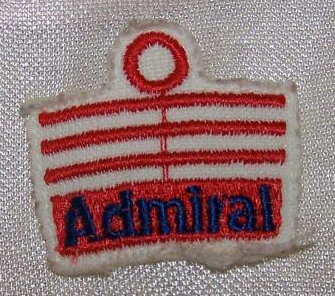 |
.jpg)
 P 39 W 21 D 9
L 9 F 65:A 29 P 39 W 21 D 9
L 9 F 65:A 29
65% successful |
|
Description |
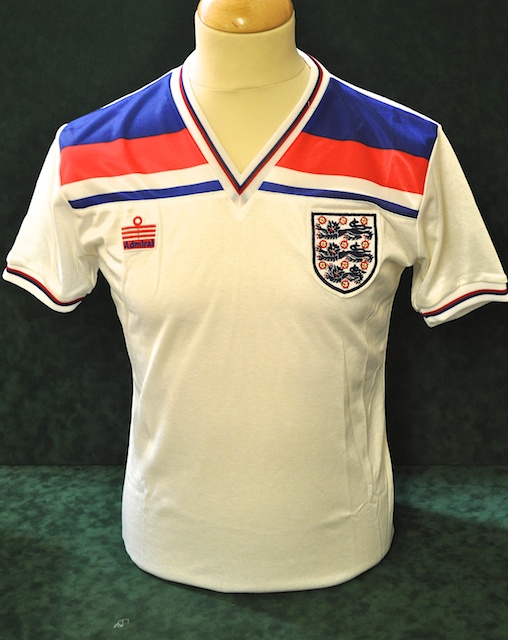 |
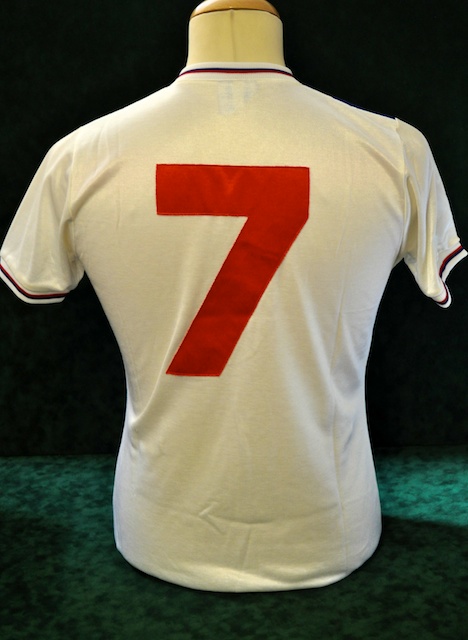 |
 |
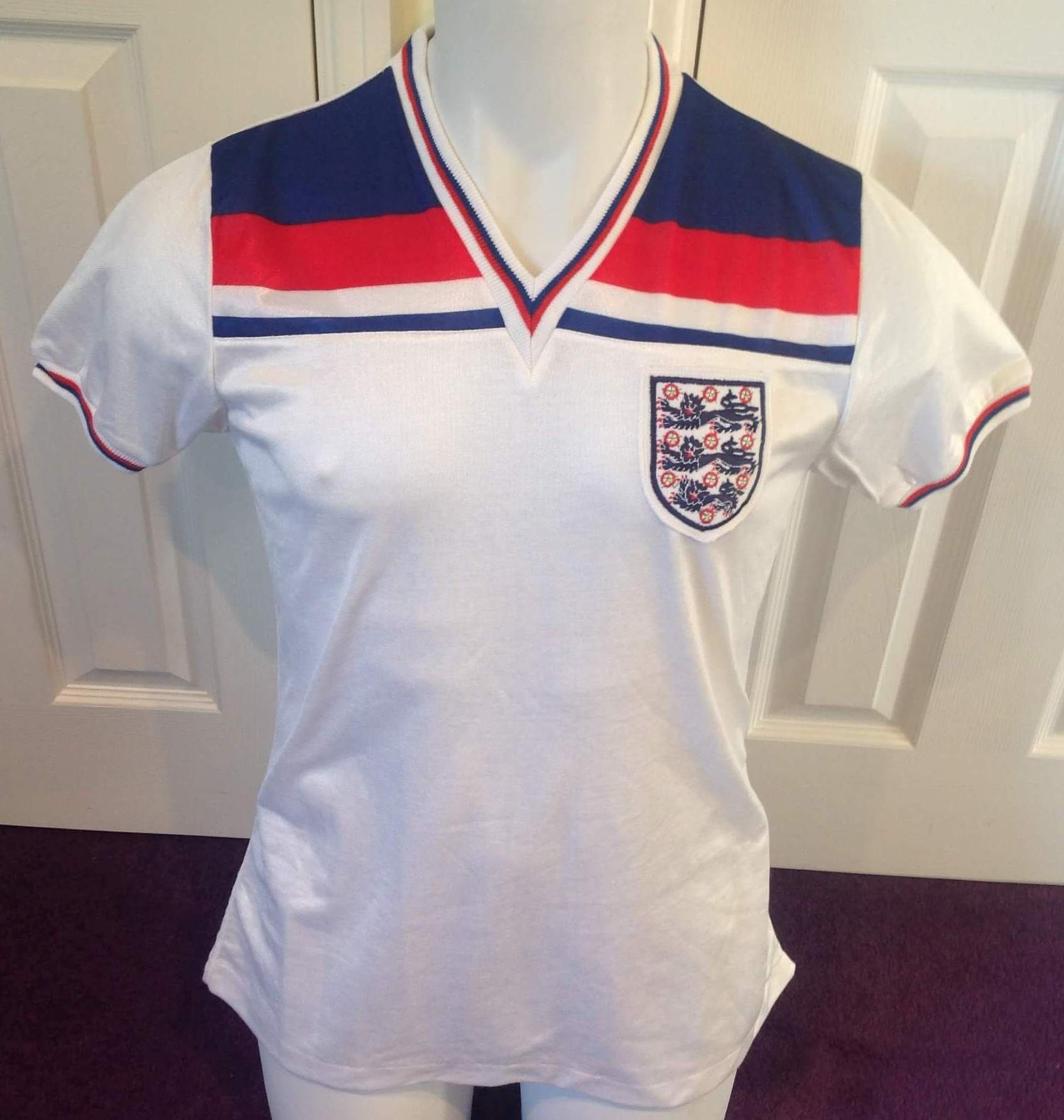 |
- White
short-sleeved shirt.
Deep white
v-neck, with thin red and royal-blue stripe in middle. White cuffs, with
thin red and royal-blue stripe in middle. Thick royal-blue panel across
shoulders, either side of v-neck, with slightly thinner red panel
directly underneath, across collarbone, either side of v-neck. Thin
royal-blue line across breast, either side of base of v-neck. Emblem
underneath thin blue line on left breast on a white embroidered patch. New-style
embroidered red logo on right breast, underneath thin blue line, overlaid
with 'Admiral' in royal-blue title case lettering at the bottom, all
within a white border. Red numbers on back
in updated Admiral font from 1978.
- Royal blue shorts,
with white drawstring. White seams, with a thick red vertical stripe in the
middle and a thin royal-blue vertical stripe on each side of the central red
stripe. New-style embroidered red logo on left thigh, overlaid with 'Admiral' in royal-blue title
case lettering at the bottom, all within a white border.
- White socks, with
red and royal-blue stripe across tops (the same as for the 1974 white
kit).
|
|
Variations |
- The Admiral logos
were removed from the shirts and shorts for the duration of the 1980
European Championship final tournament in Italy.
- A lighter,
cellular material was used for the main body and sleeves of the shirts
worn against Kuwait and Spain in 1982. The red, white and blue yoke across
the shoulders and collarbone was polyester.
- A white logo with
'Admiral' in red was worn at the base of the first digit of the shirt number against Kuwait
(apart from the number four, where it was positioned where the horizontal
and vertical lines cross) and for every game in 1983 in which the shirt was worn, apart from the final
game in Luxembourg.
- A white logo with
'Admiral' in red was worn on both of the digits of the shirt number against
West Germany and Luxembourg at Wembley in 1982.
- Against West Germany
at Wembley, the Admiral logo at the base of the
.jpg) number two on the back of
Gary Mabbutt's shirt was positioned at the right-hand edge of the digit. number two on the back of
Gary Mabbutt's shirt was positioned at the right-hand edge of the digit.
-
Against Luxembourg at Wembley, the Admiral logo at the base
of the
.jpg) number two on the back of Phil Neal's shirt was positioned at the
left-hand edge of the digit. number two on the back of Phil Neal's shirt was positioned at the
left-hand edge of the digit.
- Only Paul Mariner
wore an Admiral logo at the base of his number for the final game that this
shirt was worn, in Luxembourg, after he changed his shirt following a
blood-stained head injury sustained when he scored the second goal, his last
for England.
- For the three games
in which this kit was worn at the 1982 World Cup final tournament in
Spain, England wore white numbers on the right thigh in a different font to
that on the back of the shirt. Against Czechoslovakia and Kuwait, the
Admiral logo was positioned above the number, whilst against Spain (below), it
returned to its usual position, on the left thigh (apart from on goalkeeper,
Peter Shilton's shorts).

- At the beginning of
the 1981-82 season, against Norway, a new sock design was introduced. The red and blue
stripe across the tops was replaced by a thick royal-blue hoop, overlaid
with red Admiral logos, but without the 'Admiral' lettering.
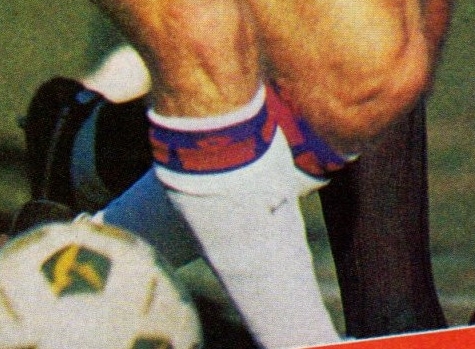
- England reverted
to the original sock design, without the Admiral logos, for the three
games in which this kit was worn at the 1982 World Cup final tournament
in Spain.
- The second sock
design was then used for the last twelve games in which this kit was worn
with white socks.
|
|
Most Appearances |
28 - Kenny Sansom
24 - Paul Mariner
23 - Phil Neal
-
29
players made their international debut in the shirt, including John Barnes,
who went on to win 79 caps, and Terry Butcher, who won 77.
-
Thirty
players won their last cap in the shirt, including Dave Watson (his 65th
cap), Kevin Keegan (63rd) and Emlyn Hughes (62nd).
-
Eleven
players won all of their caps in this shirt, including Garry Birtles, Steve
Foster and Derek Statham, who won three caps each.
|
|
Top Scorers |
9 - Paul Mariner
7 - Trevor Francis
6 - Tony Woodcock
-
Nine
players scored their first international goal in this shirt, including Bryan
Robson, who went on to score 26.
-
Fifteen
players scored their last international goal in this shirt, including Kevin
Keegan's 21st.
-
Six
players scored all of their international goals in this shirt, with Luther Blissett's
three, all coming in one match against Luxembourg, at Wembley, in 1982.
|
|
Captains |
11 - Kevin Keegan
5 - Phil Thompson
4 - Mick Mills, Bryan Robson
3 - Ray Wilkins
2 - Dave Watson
1 - Trevor Cherry, Emlyn Hughes,
Phil Neal
-
Only three of the nine had not captained England
before (Cherry, Neal and Wilkins).
-
Four defenders wore this shirt when they captained England for the last time
(Hughes, Mills, Thompson and Watson).
|
|
|
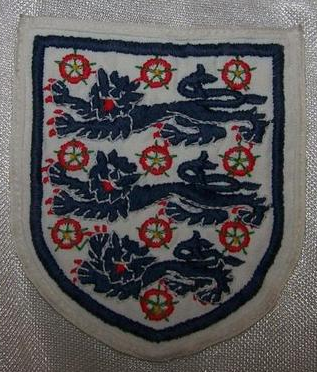
,%20Graham.bmp) England celebrated the end of the barren spell
that was the 1970s, by qualifying for the finals of the European Championship as
the tournament expanded to eight teams. England celebrated the end of the barren spell
that was the 1970s, by qualifying for the finals of the European Championship as
the tournament expanded to eight teams.
In the six years that England had been wearing
Admiral kit, they had experienced successive failures to win their qualifying
groups in the European Championship and World Cup, but the arrival of Ron
Greenwood as manager in 1977 had seen a new optimism and the run-up to Europa
'80 in Italy was filled with a genuine belief that England were about to reclaim
lost glories. A new kit design
was commissioned to commemorate the forthcoming event and was unveiled for the
first time prior to the game against Spain in March, though England wore their
1974 kit for the last
time in Barcelona.
Admiral came up with an even more flamboyant effort. Remember, this was the time
when England stood behind the union flag, not yet the cross of St George. So,
it was red, white and blue that comprised the outfit and England emerged
looking like they were carrying the union flag on their shoulders. It was a
shock for the traditionalists, who still yearned for the success of the sixties,
when England were bedecked in plain white shirts and navy shorts. In later
years, however, this second and last Admiral home shirt took on cult status
and was much sought after by collectors.
The game chosen for its debut was a prestigious
Wembley friendly against the world champions, Argentina, who numbered, in their
ranks, a 19-year-old called Diego Maradona. The prodigy would have his day in
the future at England's expense, but on this occasion, it was Kevin Keegan and
company who stole the show. A convincing 3-1 victory made the world sit up and take notice.
Who could stop England now in the little old European Championship? Italy,
that's who. Before that, just four days after Argentina, Wales were to burst the
England bubble with their biggest ever victory against their illustrious
neighbours, who would argue that it was an experimental eleven that travelled to
Wrexham. England never really
got going in Italy, in their modified kit, without the Admiral logos. Rioting
fans and tear gas interrupting the opening game in Turin didn't help. Neither
did some strange team selections against the host nation, three days later.
The Admiral Sportswear brand was sold to another company
in 1980, but the Football Association continued to honour the
contract that they had signed.
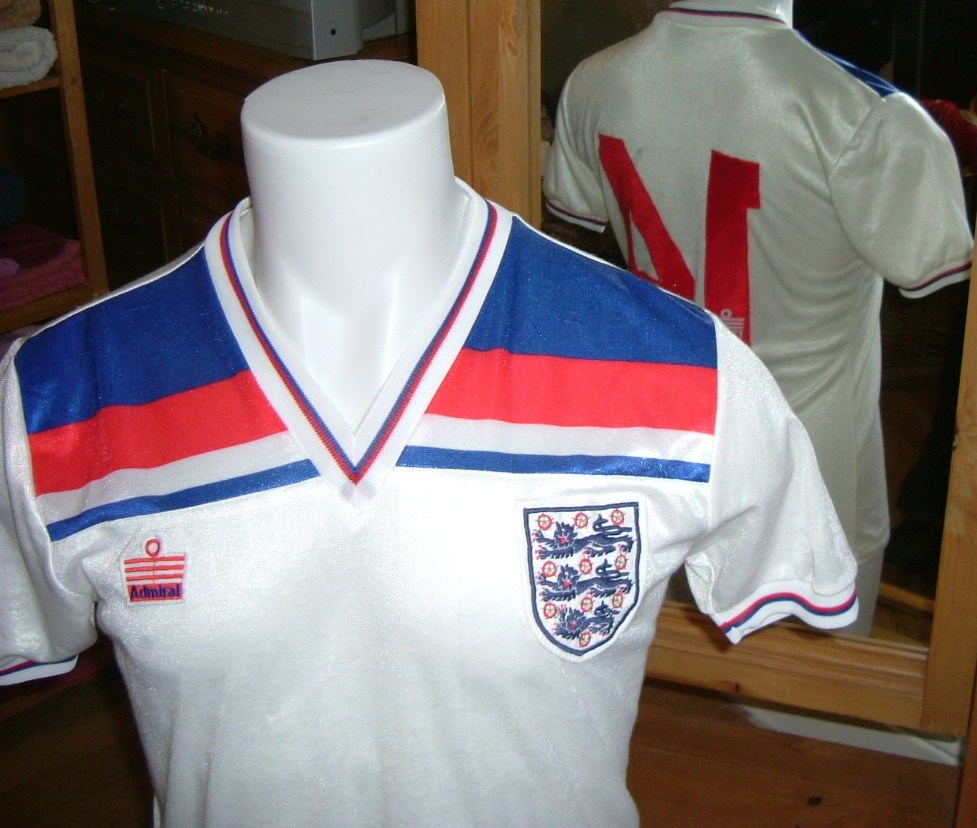 The
following World Cup campaign was a rollercoaster ride of emotions, with England
qualifying despite suffering three defeats on the road. When the time came, England hit the ground running
and finally began to show their true potential, despite the loss of Keegan and
Brooking through injury and a mysterious set of inconsistencies in the kits that
were worn in Spain. The
following World Cup campaign was a rollercoaster ride of emotions, with England
qualifying despite suffering three defeats on the road. When the time came, England hit the ground running
and finally began to show their true potential, despite the loss of Keegan and
Brooking through injury and a mysterious set of inconsistencies in the kits that
were worn in Spain.
A new set of lighter shirts was sent out for the Kuwait game
because the players had complained that the red polyester ones worn against
France had
been too heavy for the hot conditions. The suppliers took the opportunity to
slip an additional Admiral logo onto the back of the shirts, though strangely,
it had disappeared for the game against the hosts. This cannot have been a
FIFA ruling as Austria and Northern Ireland wore manufacturers' logos
within their numbers, and Belgium's kit contained an inordinate number of
Admiral logos, seemingly without restriction. The following season
provided more evidence of a lack of clarification as to exactly what the
rules were regarding these additional logos:
-
Denmark (European
Championship) - it appears that they had planned to wear the logos,
but were presumably told not to by UEFA, as the logos were coloured in
with red felt pens, rendering them invisible.
-
West Germany
(Friendly) - the logos appeared in both digits (presumably acceptable
for friendlies).
-
Greece (European
Championship) - England wore the red change kit without logos within
the numbers (as per UEFA regulations?).
-
Luxembourg
(European Championship) - the logos appeared in both digits (had the
rules changed?).
-
Wales (British
Championship) - the logos appeared only in the first digit (and this
would be the same for every game for the rest of the year (except the
last game in Luxembourg - see above).
England continued to wear the kit until the end of
the contract, which coincided with their failure to qualify for the 1984
European Championship in France. Once more, England were in a trough and the
FA looked to start afresh with a new kit manufacturer, one with a more stable
future. It turned out to be an old friend...
The shirts displayed at the top of the page were
worn by Kevin Keegan (number seven, first two photos from the left), Kenny Sansom (number three)
and David Johnson (far right). Sansom's
was worn after the 1982 World Cup and sports the additional Admiral logo at the
base of the number. Our thanks to Simon Shakeshaft, curator of
the
Neville Evans National Football Shirt Collection, for supplying
the Keegan and Sansom shirt photos. Johnson's,
without the Admiral logo, was worn against Belgium in the 1980 European Championship
(thanks to Richard Clarke's 'Three Lions - England Match Worn Shirts' Facebook
Collection). |
|
Matches in which England wore the
1980 Home White Uniform |
|
539 |
13 May 1980 -
England
3 Argentina 1 [1-0]
Wembley Stadium, Wembley, London (92,000) |
Johnson (2), Keegan
Passarella (pen) |
HW |
|
British Championship |
|
540 |
17 May 1980 -
Wales 4 England
1 [2-1]
Racecourse Ground, Mold Road, Wrexham (24,236) |
Thomas, Walsh, L.James,
Thompson OG
Mariner |
AL |
|
541 |
20 May 1980 -
England
1
Northern Ireland 1 [0-0]
Wembley Stadium, Wembley, London (33,676) |
Brotherston OG
Cochrane |
HD |
|
542 |
24 May 1980 -
Scotland 0 England
2 [0-1]
Hampden Park, Mount Florida, Glasgow (88,000) |
Brooking, Coppell |
AW |
|
Winfield Cup
celebrating Australian F.A. Centenary |
|
543 |
31 May 1980 -
Australia 1 England
2 [0-2]
Sydney Cricket Ground, Moore Park, Sydney (30,084) |
Cole (pen)
Hoddle, Mariner |
AW |
|
European Championship Finals in Italy |
|
544 |
12 June 1980 -
Belgium 1 England
1 [1-1]
Stadio Comunale di Torino, Santa Rita, Torino (15,186) |
Ceulemans
Wilkins |
ND |
|
545 |
15 June 1980 -
England
0
Italy 1 [0-0]
Stadio Comunale di Torino, Santa Rita, Torino (59,649) |
Tardelli |
AL |
|
546 |
18 June 1980 -
Spain 1 England
2 [0-1]
Stadio San Paolo, Fuorigrotta, Napoli (14,440) |
Dani (pen)
Brooking, Woodcock |
NW |
|
548 |
15 October 1980 -
Romania 2 England
1 [1-0]
Stadionul 23 August, Sector
2, Bucureşti (75,000) |
Răducanu,
Iordănescu
(pen)
Woodcock |
AL |
|
England
wore all white, the white home shirt and socks with the 1974 white away shorts, against Romania. |
|
549 |
19 November 1980 -
England
2
Switzerland 1 [2-0]
Wembley Stadium, Wembley, London (69,000) |
Tanner
OG,
Mariner
Pfister |
HW |
|
Friendly match |
|
550 |
25 March 1981 -
England
1
Spain 2 [1-2]
Wembley Stadium, Wembley, London (71,840) |
Hoddle
Satrústegui, Zamora |
HL |
|
England wore all white, the white home shirt
and socks with the 1974 white away shorts, against Spain. |
|
World Cup Finals in Spain |
|
566 |
20 June 1982 -
England
2
Czechoslovakia 0 [0-0]
Estadio San Mamés, Basurtu, Bilbao (41,123) |
Francis,
Barmoš OG |
NW |
|
567 |
25 June 1982 -
England
1
Kuwait 0 [1-0]
Estadio San Mamés, Basurtu, Bilbao (39,700) |
Francis |
NW |
|
569 |
5 July 1982 -
Spain 0
England
0 [0-0]
Estadio Santiago Bernabéu, Chamartín, Madrid (75,000) |
|
ND |
|
570 |
22 September 1982 -
Denmark 2 England 2 [0-1]
Idrætsparken, Indre Østerbro, København
(44,300) |
Hansen (pen), Olsen
Francis
(2) |
AD |
|
Friendly match |
|
571 |
13 October 1982 -
England 1
West Germany 2 [0-0]
Wembley Stadium, Wembley, London (67,500) |
Woodcock
Rummenigge (2) |
HL |
|
England wore the white home shirt and blue
shorts with the 1982 red away socks, against West Germany. |
|
European Championship Preliminary match |
|
573 |
15 December 1982 -
England 9
Luxembourg 0 [4-0]
Wembley Stadium, Wembley, London (33,980) |
Moes OG,
Coppell, Woodcock, Blissett (3),
Chamberlain, Hoddle, Neal |
HW |
|
British Championship |
|
574 |
23 February 1983 -
England 2
Wales 1 [1-1]
Wembley Stadium, Wembley, London (24,000) |
Butcher, Neal (pen)
Rush |
HW |
|
European Championship Preliminary match |
|
576 |
27 April 1983 -
England 2
Hungary 0 [1-0]
Wembley Stadium, Wembley, London (54,000) |
Francis, Withe |
HW |
|
British Championship |
|
577 |
28 May 1983 -
Northern Ireland 0 England 0 [0-0]
Windsor Park, Donegall Avenue, Belfast (28,750) |
|
AD |
|
578 |
1 June 1983 -
England 2
Scotland 0 [1-0]
Wembley Stadium, Wembley, London (83,000) |
Robson, Cowans |
HW |
|
European Championship Preliminaries |
|
582 |
21 September 1983 -
England 0
Denmark 1 [0-1]
Wembley Stadium, Wembley, London (82,500) |
Simonsen (pen) |
HL |
|
583 |
12 October 1983 -
Hungary 0 England 3 [0-3]
Népstadion, Istvánmezõ, Budapest (19,956) |
Hoddle, Lee, Mariner |
AW |
|
584 |
16 November 1983 -
Luxembourg 0 England 4 [0-2]
Stade Municipal, Rollengergronn-Belair-Nord, Stad
Lëtzebuerg (83,000) |
Robson (2), Mariner, Butcher |
AW |
|
Other match in which England wore
the 1974/80 Home White Socks |
|
Season 1981-82 |
|
565 |
16 June 1982 -
England
3
France 1 [1-1]
Estadio San Mamés, Basurtu, Bilbao (44,172) |
Robson (2), Mariner
Soler |
NW |
|
England
wore the 1982 red away shirt with the white away shorts, but wore the
1980 white home socks, against France. |
|
The Under-21 and Youth
teams wore the same design, except that each wore an embroidered
scroll below the emblem on a white rectangular patch, within which was displayed, in navy blue, either INTERMEDIATE (for the Under-21s) or YOUTH (for the Under-20s
and below).
Both England's B team and the Semi-Professional team wore an
identical kit to the full international team, without the scrolls. When the
Under-20s played in Australia in the World Youth Championship in
1981, they wore white numbers on the right thigh of their shorts in
a different font to that on the back of the shirts.
|
England's Record wearing the 1980 Home
Shirt |
|
Type |
P |
W |
D |
L |
F |
A |
GD |
FTS
|
CS |
FAv |
AAv |
Pts % |
W/L |
|
Home |
16 |
10 |
2 |
4 |
34 |
10 |
+24 |
3 |
8 |
2.125 |
0.625 |
68.8 |
+6 |
|
Away |
19 |
8 |
6 |
5 |
25 |
17 |
+8 |
4 |
9 |
1.316 |
0.895 |
57.9 |
+3 |
|
Neutral |
4 |
3 |
1 |
0 |
6 |
2 |
+4 |
0 |
2 |
1.50 |
0.50 |
87.5 |
+3 |
|
Total |
39 |
21 |
9 |
9 |
65 |
29 |
+36 |
7 |
19 |
1.667 |
0.744 |
65.4 |
+12 |
,%20Kevin.JPG) ,%20Graham.JPG)
(far left)
Kevin Keegan lines up against
Spain on June 18th, 1980. Note the absence of Admiral logos. Kit
manufacturers were not allowed to advertise their products during the European
Championship in Italy.

(left)
The practice of adding an Admiral logo to
the base of the number, began at the 1982 World Cup and continued intermittently
until the end of the Admiral contract in November 1983. England did not
use the space again until 2004, when the Three Lions emblem appeared in the same
place.
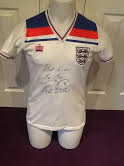 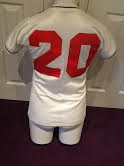
A
shirt issued to Peter Withe for the 1982 World Cup.
From Richard Clarke's 'Three Lions - England Match Worn Shirts' Facebook
Collection.
CG/GI/PY/JB
|
|